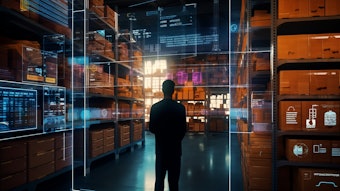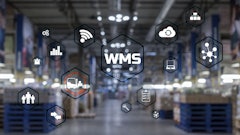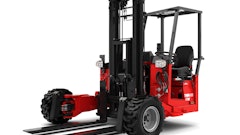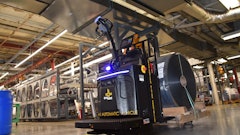
Using advanced technology to overcome the chasm between planning and operations significantly reduces cost, increases customer service, and enables process automation that reduces stress.
Systems don’t talk to each other.
Companies have implemented multiple disparate systems that don’t coordinate with one another.
- Planning systems:
- Demand: determine what is likely to sell
- Supply: generates replenishments to both manufacturing and customer-facing distribution centers (DCs)
- Order Management Systems (OMS): keep track of both customer and internal movements
- Transportation Management Systems (TMS) automate many historically manual tasks around rate management and tendering
- Warehouse Management Systems (WMS) control the ins and outs of each building
Planning does its thing on one side of the chasm.
With limited exceptions, planning doesn’t consider operations in its deployment decisions. Instead, spurred by customer demand and “always-wrong” forecasts, it deploys inventory independent of cost or constraints. This generates flow volatility among supply points and DCs. It's not planning's fault – instead, the metrics of customer fill rate and customer and consumer behavior drive the decisions. For example, more than 70% of grocery shopping in North America is done over the weekend. Grocers replenish the stores and, at the same time, replenish their warehouses. Their suppliers receive many purchase orders early in the week and must ship quickly. Supply planning systems see the spike in requirements and react to create spikes in the supplier supply chain. Simply put, on any day, the trucks to the customer-facing distribution centers can go from a few to hundreds—many of which may not be able to be unloaded.
On the other side of the chasm, customers and operations suffer.
Volatility gets passed to operations because supply planning’s goal is to generate high order-fill and doesn’t concern itself with:
- That carriers have limited capacity. In the event of a volume spike, the tenders cascade to less and less desirable carriers, and often, the TMS has to resort to brokers with their inherent risks. At other times, partner carriers are left without volume and need deadhead equipment to find alternate loads.
- Warehouses have limited space. Once they get close to full, receiving more products than they can efficiently store generates significant additional labor and detention. In the worst case, it can result in a site needing product on a yard van that cannot be unloaded. The customer misses out. The impact on the critical measure of OTIF (On-time, in full) can be extremely costly.
- Dock workers can be stretched as throughput capacity rises. Often, high replenishment volume coincides with a significant number of customer shipments. Companies generally give preferential treatment to customer shipments. The result is trailer detention and potential damage to the critical OTIF measure.
Using all the data to bridge the chasm.
In today’s world of many hands-on planners making day-to-day decisions, there is simply no capability to utilize all the data from operations and planning. On Monday most planners are looking to determine what to deploy on Friday. They build the shipments and move on. But there is a wealth of data that is just too much for a planner to comprehend; this data comes from:
- The supply planning system. Most give expected daily movements for the next few weeks and the priority of need for each item.
- Forecasts and OMS: what customer orders will need to be shipped, and how much load will this put on the DCs and plants
- TMS: what is the cost and availability of carriers on each lane, and what are the transit times
- WMS: what space is available
- Calendar: when are sites open
The Big Data Solution
Companies have all the data, but looking at just minimizing cost is insufficient. Importantly, optimizing the supply chain requires:
- Ensuring that customer service levels are maintained or improved.
- The digital twin created for the supply chain behaves like the real world. So, for example, because most companies ship in full truckloads, it is necessary to consider the movements in truckloads rather than at the individual SKU level.
- A holistic solution. For example, moving additional high-priority loads from one plant to a given distribution center may mean that other sites supplying the same DC need to reduce their volume.
Translating all this into a helpful solution is challenging, but it has been done. Level loading technology has successfully brought together all the information, quickly performed optimization, and managed the deployment network for a large consumer product company. The following diagram shows the standard and level-loaded processes that bridge the gulf between planning and operations. ProvisionAI
ProvisionAI
Additionally, because a level loading process considers transportation needs many days into the future, it’s possible to pre-reserve carriers' equipment. Then, much closer to the shipping time, the highest priority product fills the previously reserved capacity.
The big-data solution produces significant results.
Level loading eliminates many of the pain points supply chain companies complain about:
- Cost.
- Transportation costs are substantially reduced as first tender acceptance rises significantly.
- Detention costs decline.
- Warehouse overtime is reduced.
- Customer service: On time, in full (OTIF) customer service improves
- Manual effort is shifted to automation
- Environmental: Scope 3 emissions are reduced as carriers operate more efficiently
While it’s possible to talk about abstract measures, like the coefficient of variation being reduced by 60%, a graph of shipments per day shows the significant improvement on a single lane: ProvisionAI
ProvisionAI
It should also be noted that leveling doesn’t make things perfectly smooth. Instead, it reacts to customer needs that may not have been well forecast. After all, maintaining high customer service is more important than saving a few thousand dollars on transportation.
Level loading bridges the chasm that lies between planning and operations. With big data and optimization, it's possible to improve operations significantly. Now, plans consider operational constraints while improving customer service.


























